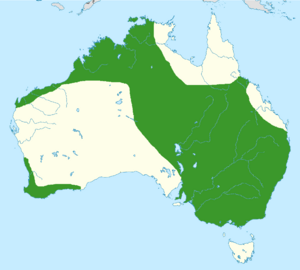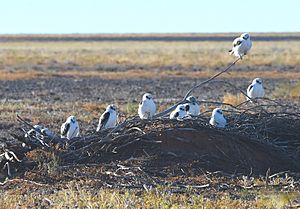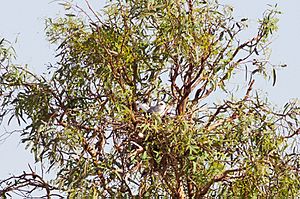Letter-winged kite facts for kids
Quick facts for kids Letter-winged kite |
|
|---|---|
 |
|
| Conservation status | |
| Scientific classification | |
| Genus: |
Elanus
|
| Species: |
scriptus
|
 |
|
| Range of the letter-winged kite (2007) | |
The letter-winged kite (Elanus scriptus) is a small and special bird of prey found only in Australia. It's quite rare and its numbers can change a lot. This bird is about 35 cm (14 in) long, with a wingspan of 84 to 100 cm (33 to 39 in).
Adult letter-winged kites are mostly pale grey and white. They have bright red eyes with black rings around them. Their name comes from a cool black pattern under their wings. When they fly, this pattern looks like a shallow 'M' or 'W'. This helps tell them apart from the similar black-shouldered kite.
These kites start breeding when there are lots of rodents around. They build nests in groups, sometimes with up to 50 pairs. They usually lay three or four eggs, which hatch in about 30 days. If their food supply disappears, they might leave their eggs. Young kites can fly within five weeks of hatching. Letter-winged kites usually rest in leafy trees during the day. They hunt mostly at night, looking for rodents. They are very good at catching rodents by hovering in the air over grasslands. This bird is listed as "near threatened" by the International Union for Conservation of Nature (IUCN).
Contents
About the Letter-winged Kite's Name
The letter-winged kite was first described by a bird expert named John Gould in 1842. Its scientific name is Elanus scriptus. The word scriptus comes from Latin and means "written" or "marked," which fits the bird's unique wing pattern.
People in Central Australia who speak the Pitjantjatjara dialect call this bird nyanyitjira. The name "Letter-winged kite" is the official English name. It comes from the letter-like marks under its wings.
What the Letter-winged Kite Looks Like
An adult letter-winged kite is about 35 cm (14 in) long. Its wings can spread out between 84 and 100 cm (33 and 39 in). Female kites are a bit heavier, weighing about 310 g (11 oz), while males weigh around 260 g (9.2 oz). Both males and females look very similar.
Adult males have light grey backs, wings, and neck. Their heads and undersides are white. They have big, deep-red eyes with a black patch around them. Their beak is black, and their legs and feet are a pinkish-white color. Their feet have three toes pointing forward and one pointing backward.
The most special part is their wings. They have a black patch on top of the shoulder. Underneath, there's a clear black line that looks like an 'M' or 'W' when the bird is flying. This helps you know it's a letter-winged kite! Females look similar but might have a slightly greyer head and darker grey feathers overall.
Young kites look a bit different. They have a white lower face and throat, with a brownish-orange band across their forehead and chest. Their eyes are dark brown, and their back feathers are grey-brown with orange tips.
When flying, the letter-winged kite holds its wings in a V-shape, slightly curved upwards. It can also hover in place, flapping its wings while facing the wind. This bird is different from the black-shouldered kite because of its 'M' or 'W' wing pattern and because it hunts at night. Other birds like owls might look similar at night, but they have bigger heads and different body shapes.
What Sounds Do They Make?
Letter-winged kites are usually quiet when they are alone. But when they are breeding or resting together at night, they can be quite noisy. They often start calling when the moon rises. Their calls sound like chicken chirps or a loud "kacking" sound. Sometimes, their calls are similar to barn owls or black-shouldered kites.
A special rasping call, like a "scrape," is used by a pair to talk to each other. The female often uses it to answer her mate's whistle. The male can make a loud whistle while flying, which can be a warning call. Mated pairs also chatter to each other at night in their groups.
Where Letter-winged Kites Live
Letter-winged kites usually live in dry and semi-dry open areas with shrubs or grass. They are found in the middle of Australia, especially in the southern Northern Territory, northeastern South Australia, and Queensland. They are rare in New South Wales and Western Australia.
How many kites there are in an area depends a lot on how much food is available. When there's a lot of rain inland, the number of rodents goes up. This causes a big increase in letter-winged kites. They can breed many times in a row, and their population can grow ten times bigger! Major increases have happened in the past, like in 1951–53 and 1993–95. But when dry weather returns, rodent numbers fall, and the kites spread out. They often starve if they can't find food somewhere else.
Letter-winged Kite Behaviour
Letter-winged kites mostly hunt at night. They might hunt during the day if there is a lot of food or very little food. During the day, they rest in leafy trees where they can hide. They often rest in groups, sometimes with up to 400 birds! It's hard to study their social behavior because they are active at night and are shy when resting.
Reproduction and Life Cycle
Letter-winged kites usually breed in areas around the Diamantina River and Lake Eyre basin in Australia. They also breed in parts of the Northern Territory and New South Wales.
It's not known if breeding pairs stay together after they have young. During courtship, the male and female fly high above the nest. The male flies higher and flutters his wingtips quickly. He then drops near the female, and they chatter while circling each other. They often mate after this display.
There isn't a specific breeding season for these kites. Instead, they start nesting in groups when there's a sudden increase in rodents. They keep having babies as long as there's plenty of food. If food becomes scarce, they stop breeding. Sometimes, more than one nest can be in the same tree if there's a lot of food.
Their nest is a large, messy, and shallow cup made of sticks. It's usually built high up in leafy trees, about 5 metres (15 ft) or more off the ground. The nest is about 50 cm (20 in) wide and 34 cm (13 in) high, with a cup-shaped dip inside that's about 20 cm (7.9 in) across. They line the nest with green leaves and other things, like pellets they have coughed up.
They lay three to four eggs, but sometimes five or even six. The eggs are dull white with red-brown spots, especially at the wider end. The female sits on the eggs for 30 days. The young birds are born with white down feathers, black beaks and feet, and dark brown eyes. By one week old, they have light tan down on their backs. They have all their feathers by 3–4 weeks and can fly at 7 weeks.
While the young are growing, the female stays with them, and the male brings food at night. He calls when he's close, and the female flies out to get the food and then feeds it to the young. As the young grow, the female also starts hunting for food. Sometimes, she might even start a second group of babies and leave the male to feed the older ones. Young kites leave the nest at about 32 days old. However, if the food supply suddenly runs out, the young might be left alone. Young kites can start having their own babies within their first year.
What Letter-winged Kites Eat and How They Hunt
Letter-winged kites mainly hunt in the first two hours after sunset. They fly about 10 to 20 m (33 to 66 ft) high, circling widely and looking at the ground. Then they hover up to 30 m (98 ft) high. When they spot prey, they drop silently onto it, feet first, with their wings held high.
Their main food is the long-haired rat. When there are many of these rats after heavy rain, the kites can breed all the time, and their numbers grow. One study found that kites moved to areas with rat outbreaks within six months. When the rat numbers drop, the many kites might fly to coastal areas far from where they usually live. They might breed there sometimes, but they don't stay and eventually disappear.
Letter-winged kites eat about one rodent a day. They also hunt other animals like the house mouse, rabbits, and different types of small mice and marsupials. They have also been seen eating beetles and locusts.
Who Hunts the Letter-winged Kite?
Black falcons have been seen hunting adult letter-winged kites. Also, black kites have been known to take young kites from their nests.
Protecting the Letter-winged Kite
It's hard to know exactly how many letter-winged kites there are because their numbers change so much. They are also rarely seen by people in most places where they live. The International Union for Conservation of Nature (IUCN) lists them as "near threatened." This is because their population might drop to as low as 1,000 birds between times when rodents are abundant.
We don't know how much introduced animals like red foxes or feral cats affect the kites. We also don't know if their homes are being harmed by too much grazing by other animals. It's not clear if their population has grown or shrunk since Europeans first settled in Australia.
See also
 In Spanish: Elanio escrito para niños
In Spanish: Elanio escrito para niños





